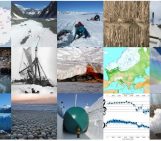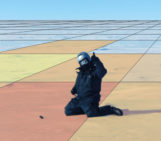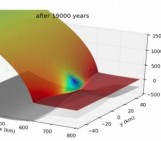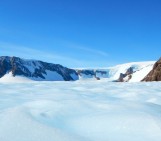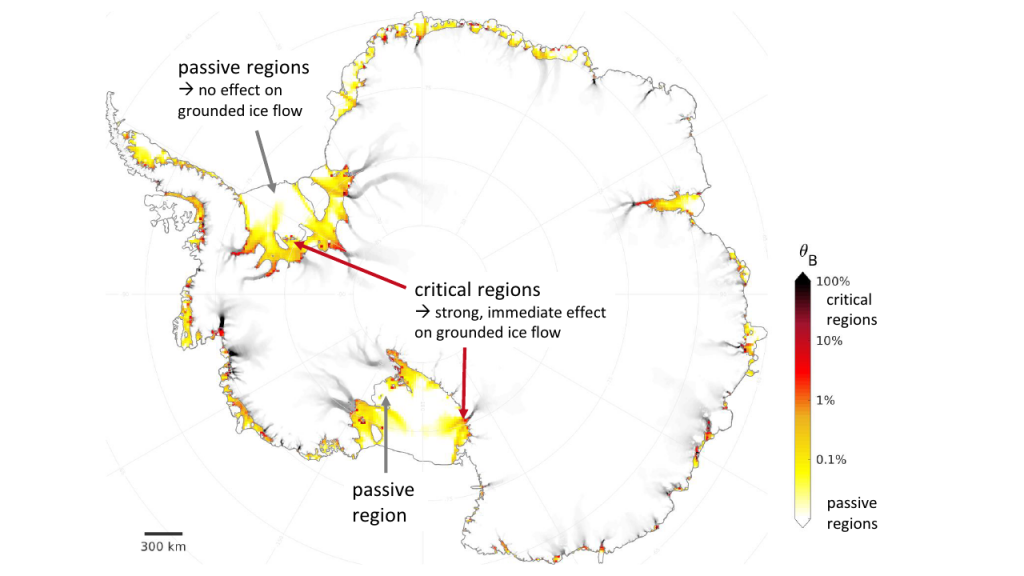
Risk map for Antarctic ice shelves shows critical ice shelf regions, where local thinning increases the ice flow from the continent into the ocean [Credit: modified from Reese et al., 2018]
Changes in the ice shelves surrounding the Antarctic continent are responsible for most of its current contribution to sea-level rise. Although they are already afloat and do not contribute to sea level directly, ice shelves play a key role through the buttressing effect. But which ice shelf regions are most important for this?
The role of ice-shelf buttressing
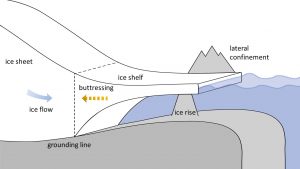
Schematic ice-sheet-shelf system: buttressing arises when an ice shelf is laterally confined in an embayment or locally grounds at pinning points [Credit: Ronja Reese & Maria Zeitz]
In architecture, the term “buttress” is used to describe pillars that support and stabilize buildings, for example ancient churches or dams. In analogy to this, buttressing of ice shelves can stabilize the grounded ice sheet (see this blog article about the marine ice sheet instability). It can be understood as a backstress that the ice shelf exerts on the grounding line – the line that separates the grounded ice from the floating ice shelves. When an ice shelf thins or disintegrates, this stress can be reduced, then the ice flow upstream is less restrained and can increase.
This effect has been widely observed in Antarctica: the thinning of ice shelves in the Amundsen Sea is driven by the ocean and linked to ice loss there (see this blog article) and after the spectacular disintegration of Larsen A and B ice shelves the adjacent ice streams accelerated.
Which ice shelf regions are important?
Risk maps show how important each ice-shelf location is: if an ice shelf thins in this location, how much does the flux across the grounding line increase? We estimated this immediate increase using the numerical ice-flow model Úa. At first glance, one can see that all ice shelves have regions that influence upstream ice flow, and thus, provide buttressing. The highest responses occur near grounding lines of fast-flowing ice streams. Equally strong responses are found in the vicinity of ice rises or ice rumples – where the ice shelf re-grounds locally and is subject to basal drag. On the other hand, “passive” regions with negligible flux response are located towards the calving front, but also in spots close to the grounding line. Flux response signals can sometimes travel quite far – for example a perturbation near Ross Island accelerates the ice flow in almost the entire Ross Ice Shelf and reaches ice streams more than 900km away (not visible in the figure).
Risk maps for Antarctic ice shelves, as presented here, help us to get a better understanding of the critical ice shelf regions – if you are interested to read more, please see for example Gagliardini, 2018 and Reese et al., 2018.
Edited by Scott Watson and Sophie Berger
 Ronja Reese is a postdoctoral researcher at the Potsdam Institute for Climate Impact Research, Germany, in the ice dynamics working group. She investigates ice dynamics in Antarctic with a focus on ice-ocean interactions and ice-shelf buttressing. She created the risk map together with Ricarda Winkelmann, Hilmar Gudmundsson and Anders Levermann. Contact Email: ronja.reese@pik-potsdam.de
Ronja Reese is a postdoctoral researcher at the Potsdam Institute for Climate Impact Research, Germany, in the ice dynamics working group. She investigates ice dynamics in Antarctic with a focus on ice-ocean interactions and ice-shelf buttressing. She created the risk map together with Ricarda Winkelmann, Hilmar Gudmundsson and Anders Levermann. Contact Email: ronja.reese@pik-potsdam.de
.

